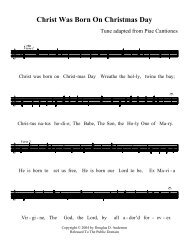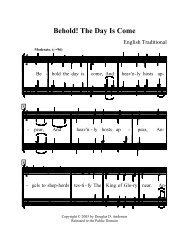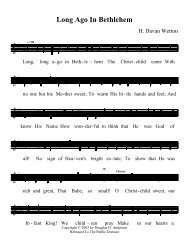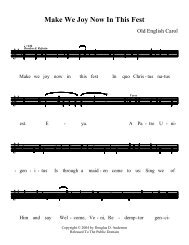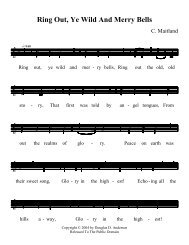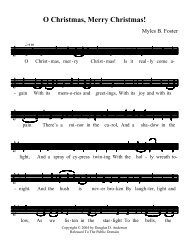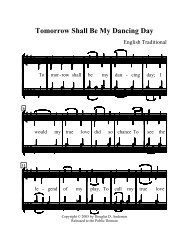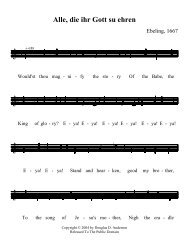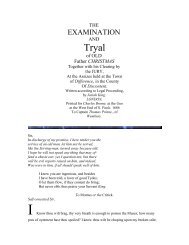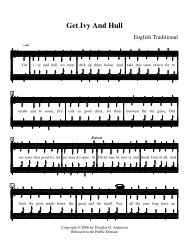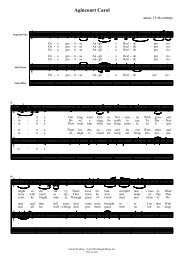Now, Now, The Mirth Comes - The Hymns and Carols of Christmas
Now, Now, The Mirth Comes - The Hymns and Carols of Christmas
Now, Now, The Mirth Comes - The Hymns and Carols of Christmas
Create successful ePaper yourself
Turn your PDF publications into a flip-book with our unique Google optimized e-Paper software.
Give then to the king<br />
And queen wassailing;<br />
And, though with ale ye be wet here,<br />
Yet part ye from hence<br />
As free from <strong>of</strong>fense,<br />
As when ye innocent met here.<br />
Compare: This version from William S<strong>and</strong>ys (1833): Twelfe Night<br />
Husk's Note:<br />
http://www.hymns<strong>and</strong>carols<strong>of</strong>christmas.com/<strong>Hymns</strong>_<strong>and</strong>_<strong>Carols</strong>/twelfe_night.htm<br />
<strong>Christmas</strong> Poetry By Robert Herrick<br />
<strong>The</strong> Twelfth Cake was formerly made full <strong>of</strong> plums, amongst which were placed<br />
a bean <strong>and</strong> a pea. <strong>The</strong> cake being cut into slices <strong>and</strong> distributed amongst the company,<br />
he to whose lot fell the piece containing the bean was the King, whilst she who<br />
obtained the piece holding the pea became the Queen, for the evening. This ceremony<br />
was also formerly practised in France, under the name <strong>of</strong> “La Roi de la Feve.”<br />
Also found in A. H. Bullen, A <strong>Christmas</strong> Garl<strong>and</strong> (London: John C. Nimmo, 1885), pp. 229-<br />
30. Concerning the reference to "Where bean’s the king <strong>of</strong> the sport here," Bullen notes:<br />
"A bean <strong>and</strong> pea were enclosed in the Twelfth-cake. When the cake was divided,<br />
he who got the slice containing the bean was king <strong>of</strong> the feast, <strong>and</strong> the girl to whose lot<br />
the pea fell was queen. This Twelfth-tide custom existed in France as early as the<br />
thirteenth century. See some interesting remarks in the preface to S<strong>and</strong>ys’ <strong>Christmas</strong><br />
<strong>Carols</strong> (pp. lxxvi—ix.)"<br />
Concerning the reference to "With gentle lambs-wool," Bullen notes<br />
"Lambs-wool consisted <strong>of</strong> strong nappy ale, in which roasted crab-apples were<br />
pressed. Nares conjectures that the name was derived from the liquor’s “smoothness<br />
<strong>and</strong> s<strong>of</strong>tness, resembling the wool <strong>of</strong> lambs.”<br />
William Hone in his <strong>The</strong> Every Day Book, has this discussion about the derivation <strong>of</strong> “Lamb'swool:”<br />
It is mentioned by a writer in the "Gentleman's Magazine," that lamb's-wool is a<br />
constant ingredient at a merry-making on Holy Eve, or on the evening before All<br />
Saints-day in Irel<strong>and</strong>. It is made there, he says, by bruising roasted apples, <strong>and</strong> mixing<br />
them with ale, or sometimes with milk. "Formerly, when the superior ranks were not<br />
too refined for these periodical meetings <strong>of</strong> jollity, white wine was frequently<br />
substituted for ale. To lamb's-wool, apples <strong>and</strong> nuts are added as a necessary part <strong>of</strong><br />
Page 19 <strong>of</strong> 72



